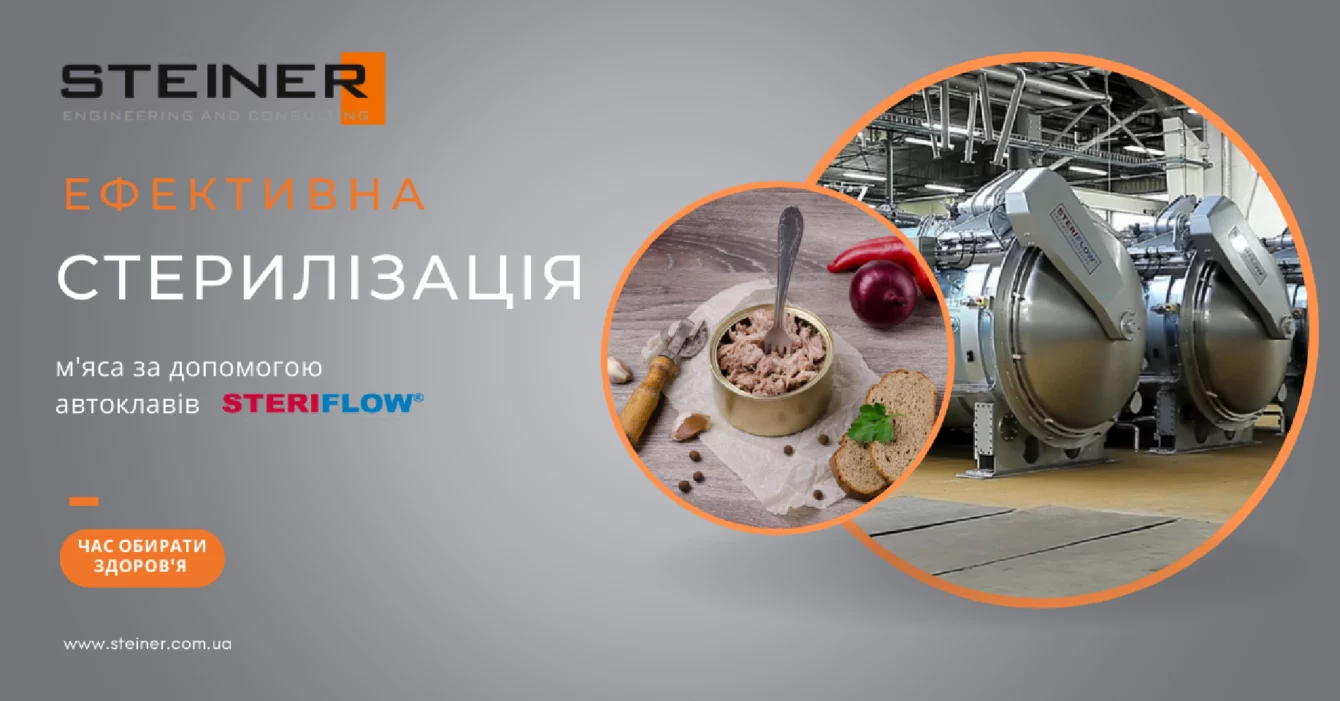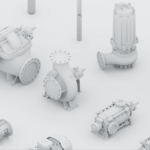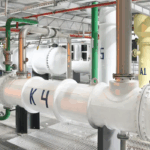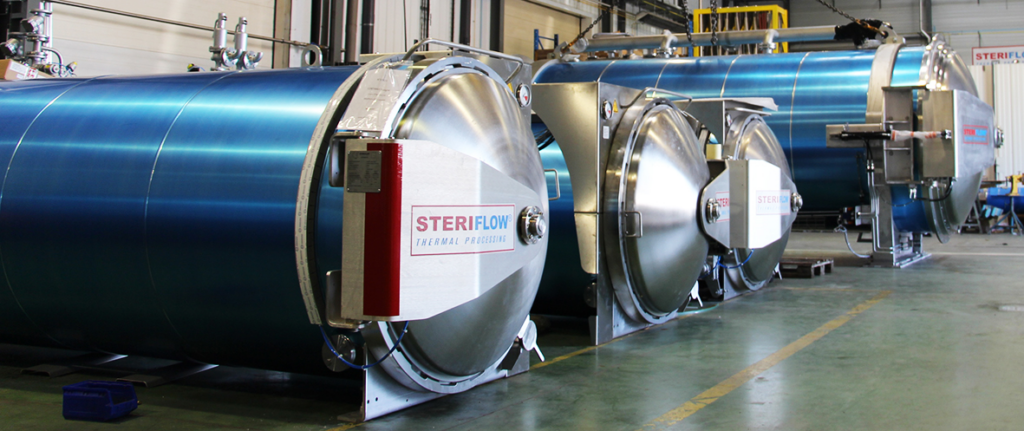
The popularity of autoclaves in the modern world is steadily growing, and for good reason. A properly selected autoclave not only facilitates enterprise operations but also ensures fast preparation and preserves the majority of nutrients and vitamins.
Numerous canning enterprises produce hundreds of types of products packaged in various types of containers: glass, tin cans, semi-rigid, soft packaging, and more. Regardless of the type of packaging or raw materials, canned products share a common feature: they all undergo high-temperature processing to eliminate microorganisms and ensure shelf stability. The value of meat, as well as other types of canned goods, lies in their long shelf life while retaining nutritional and taste qualities. These products can be quickly prepared for consumption or eaten directly without additional processing.
Tourism and outdoor enthusiasts are true connoisseurs of canned pork and beef stews, especially during hikes and nature trips. But what happens behind the scenes? Is this product truly as tasty and nutritious as it seems? How is it prepared, and what equipment is used? Let’s dive into the details!
Before canned goods reach consumers, they are sterilized in a canning autoclave.
The sterilization process involves hermetically sealing the product in a container and subjecting it to thermal processing to eliminate bacteria. The most common type of sterilization (or pasteurization) is autoclaving, performed using industrial autoclaves. While homemade stews can also be made, the preparation technology differs slightly.
For large enterprises, horizontal batch autoclaves are the most suitable in terms of technology and economy. In these autoclaves, cans are sterilized in rotating or stationary baskets. Inside the autoclave, high pressure is created, and the products are heated to achieve the following:
- Ensure canned food is resistant to external influences.
- Extend the product’s shelf life.
- Preserve the taste and nutritional qualities of the ready-made dishes.
For effective sterilization, the temperature distribution inside the autoclave must be uniform, with a deviation of no more than 1°C between packages. Additionally, it is crucial not to overcook the product, as this can waste expensive energy resources and degrade the canned food into an unappealing mass.
How to cook stew in an autoclave? Let's talk about the classic stages of cooking.
First of all, the product blanks are put into the autoclave in their raw state. Meat from various animals can be used as raw materials, including poultry, pork, lamb, beef, etc. It is important to observe the ratio of products and spices in accordance with the recipe and DSTU standards, otherwise the canned food will be bitter or have an unpleasant taste.

The cooking steps are:
- Loading the product with spices in the required quantity into the appropriate containers that have been previously inspected.
- Sealing in containers: The product and spices are loaded into pre-inspected containers.
- Heating of the device. During which the pressure gradually increases to 4 bar. To ensure that the final product is completely ready for consumption and does not contain harmful microorganisms, it is especially important to comply with the temperature regime.
- Sterilisation process. It begins after the desired temperature is set according to the recipe. It requires maintaining a stable temperature for a certain period of time.
- Product cooling. The last step is to reduce the pressure level and cool it down. Only then is the lid opened to remove the canned food.
The technological process involves heating the product to the sterilization temperature, holding it for the required time, and cooling it to room temperature. Achieving the desired result requires high-quality equipment and avoiding errors during its selection.
We offer STERIFLOW autoclaves that ensure precise temperature distribution, with a deviation of only 0.5°C between product packages. This technology preserves bright colors and the desired consistency of the product.
Water Cascade Technology:
In these autoclaves, the “water cascade” technology is used, where superheated water showers the batch of products loaded into the autoclave, similar to a rain shower. Thanks to the pressure maintenance system inside the autoclave, the water temperature reaches the required levels for sterilization or pasteurization. This also ensures the integrity of lightweight polymer packaging and retort pouches, which could otherwise burst during cooling without a pneumatic pressure control system.
The key advantage is that the superheated steam from the boiler does not directly enter the Steriflow autoclave. Instead, it transfers its energy to hot water through a specially designed fully welded Platular heat exchanger, and it is this superheated water that cascades over the loaded cans or pouches.
This setup offers a significant benefit: after the heating cycle, cold water can be introduced into the heat exchanger instead of steam, allowing for energy recovery, or reclaiming a substantial portion of the heat. This recovered heat can be reused for preheating the next batch of products before loading into the autoclave, heating cleaning solutions, boiler feed water, and more.
Each additional degree of preheating the product batch before loading into the autoclave saves 0.78% of the steam required for product sterilization. By avoiding heat waste during autoclave cooling, you can save up to 42% on gas or electricity, as confirmed by research studies.
Thanks to the “water cascade” technology, STERIFLOW autoclaves are compatible with all types of packaging, including glass jars, tin cans, retort packaging, and more. The uniform heating and cooling provided by the Platular heat exchanger eliminates thermal shock, which is especially dangerous for glass jars, and ensures perfect uniform sterilization of the entire batch.
For a technician, a STERIFLOW autoclave is a real asset in the workplace. The MPI Expert control panel makes it easy to set all the parameters for product heating and cooling cycles, while the batch processing history is stored and always available for monitoring or review. This feature significantly simplifies batch traceability, making the STERIFLOW equipment highly efficient and user-friendly.
The essence of this technology lies in the fact that heat transfer using a liquid—water in this case—is much more efficient than using steam, as is the case with traditional steam autoclaves.
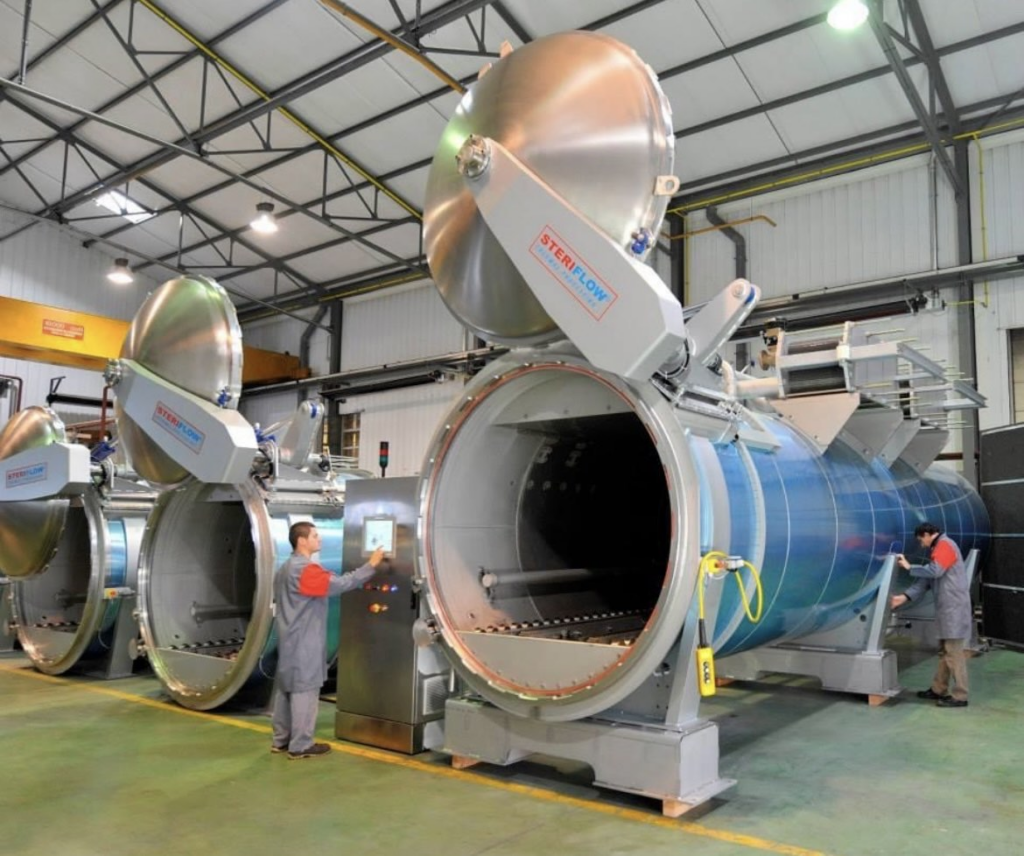
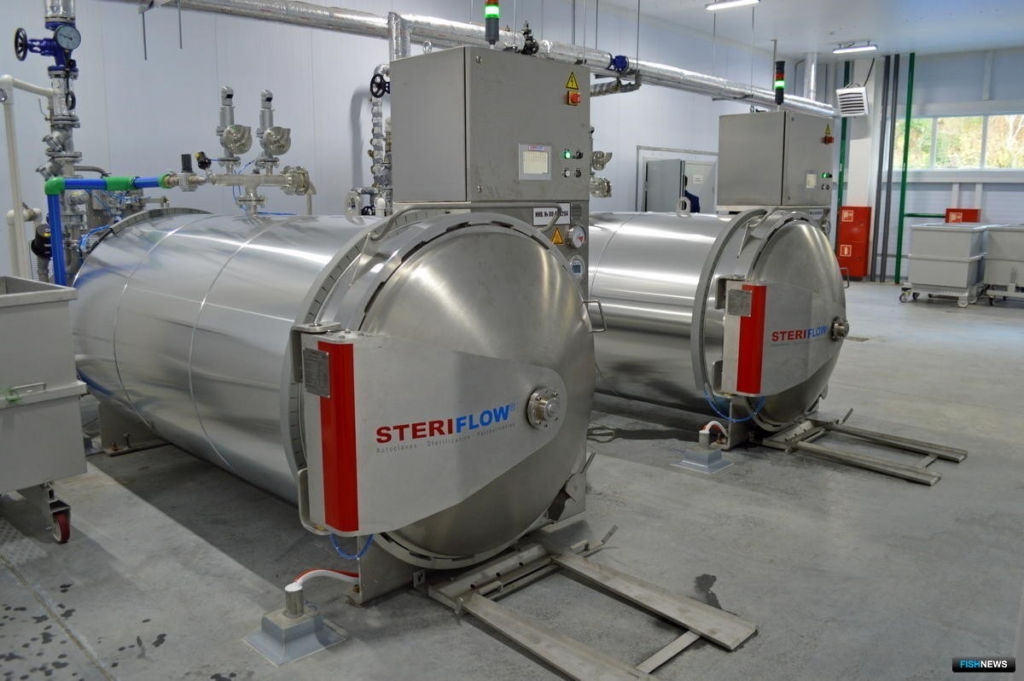
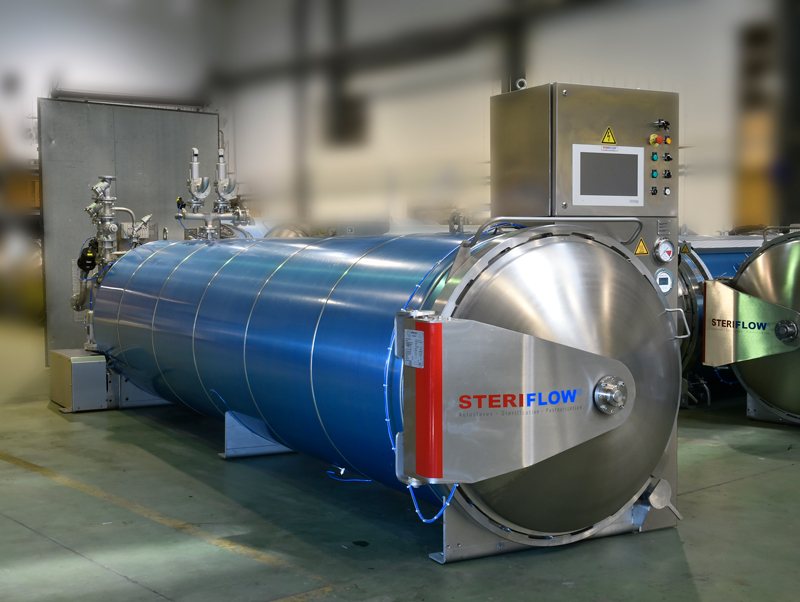
Looking for the Most Productive Equipment?
STERIFLOW (France) is a global leader in the production of horizontal autoclaves and the direct developer of the innovative “water cascade” thermal processing technology. This highly efficient method is designed for pasteurization, sterilization, or pressure cooking of vegetable, fruit, fish, meat, and dairy canned goods, as well as ready-to-eat meals, pet food, and pharmaceutical products. It accommodates virtually all types of packaging, including glass jars, tin cans, PET bottles, soft plastic packaging, plastic trays, retort pouches, Doypacks, sachets, aluminum and plastic single- and multi-component trays, and multilayer cardboard retort packages such as Tetra Recart.
STERIFLOW’s Range of Products Includes:
- Static horizontal autoclaves, capacities ranging from 1 to 11 baskets, with diameters from 900 to 2300 mm.
- Rotary (rotative) horizontal autoclave, capacities ranging from 1 to 7 baskets, with diameters from 1300 to 1800 mm.
- Laboratory autoclaves, capacities ranging from 1 to 2 baskets, with a diameter of 900 mm.
- DALI horizontal autoclaves, designed for the sterilization or pasteurization of dairy products.
- Innovative SHAKA autoclaves, featuring high-frequency shaking technology.
Perhaps the most popular models in the STERIFLOW range are the – static autoclaves. Everything is simple: baskets with products are loaded into the autoclaves and water circulation begins, which irrigates the products. We heat it up, kill all the bacteria, and cool it down to normal temperature.
Autoclaves with stirring options are so-called ‘stirring’ autoclaves, DALI system, the baskets are placed on a chain with pushers inside the autoclave. During operation, the chain moves back and forth, and the products in the packaging are shaken, which improves heat transfer. This is especially important for liquid products.
Rotary autoclaves feature a grid-like basket design. Baskets are loaded and clamped from above and below inside a special drum that rotates during thermal processing. These autoclaves offer dual advantages: the product packaging is showered from multiple directions, and the product itself is mixed, enhancing process efficiency. However, rotary autoclaves are more expensive and have a lower load capacity than static autoclaves, as the drum occupies some of the internal space. Customers can choose the model that best suits their needs.
And the last know-how from STERIFLOW is SHAKA - super shaking. These autoclaves are small, single-basket autoclaves. The basket inside is shaken at a high frequency, very sharply. This frequency of oscillation increases heat transfer and significantly reduces the cycle time, which has a positive effect on the quality of the final product. STERIFLOW SHAKA autoclaves with water cascade technology and an all-welded heat exchanger are the pinnacle of engineering. Not only is the product irrigated with superheated water, but it is also shaken horizontally by a special mechanism that accelerates heat transfer inside the packaging by up to several times! The oscillation frequency of the basket with the loaded product is up to 150 rpm. The basket design ensures the integrity of the glass container during shaking, which has been proven over the years of operation of such autoclaves in the EU.
This describes the sterilization process—high-temperature processing where products are heated above 100°C and held for a sufficient time to destroy microorganisms. As a result, the shelf life of sterilized products at room temperature can reach several years.
There is also pasteurization, where the process is conducted at a normal temperature below 100°C. The temperature and duration of pasteurization depend on the type of product and storage requirements. In this process, bacteria are suppressed, resulting in a shorter shelf life for the product but better preservation of its beneficial properties and taste qualities.
For pasteurization, these autoclaves feature an additional “no overheat” option, with another heat exchanger installed for cooling, as the main heat exchanger cannot be used for cooling during heating and holding.
Steiner-Ukraine is the official representative of STERIFLOW in Ukraine and offers professional equipment for your production needs. Whether you are looking to expand, modernize, or create a completely new production line for fruit, vegetable, meat, or fish canning—don’t hesitate to contact us!
Today, French STERIFLOW autoclaves are working reliably in Ukraine: This includes the sterilisation of canned vegetables (Agrospetsproekt LLC) and the production of sausages (Saltovsky Meat Processing Plant), canned fish (Prolyv TM), condensed milk (Imperial Plus TM Sladosvit), crab sticks in polymer packaging (Aquavit TM, Vodniy Mir TM), and pet food (Gav TM, Meow TM, Club 4 Paws TM).
The capabilities of autoclaves are not limited to sterilisation, they can also cook food!
Call us and we will help you understand in detail what you need and offer a reliable solution. We guarantee professional advice, timely execution of orders, qualified service, supply of original spare parts, support both during the warranty period for the equipment and in the post-warranty period.
